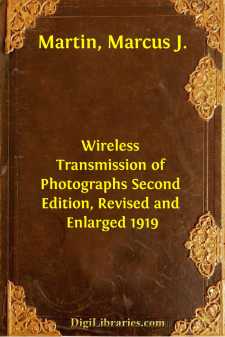Categories
- Antiques & Collectibles 13
- Architecture 36
- Art 48
- Bibles 22
- Biography & Autobiography 813
- Body, Mind & Spirit 142
- Business & Economics 28
- Children's Books 15
- Children's Fiction 12
- Computers 4
- Cooking 94
- Crafts & Hobbies 4
- Drama 346
- Education 46
- Family & Relationships 57
- Fiction 11829
- Games 19
- Gardening 17
- Health & Fitness 34
- History 1377
- House & Home 1
- Humor 147
- Juvenile Fiction 1873
- Juvenile Nonfiction 202
- Language Arts & Disciplines 88
- Law 16
- Literary Collections 686
- Literary Criticism 179
- Mathematics 13
- Medical 41
- Music 40
- Nature 179
- Non-Classifiable 1768
- Performing Arts 7
- Periodicals 1453
- Philosophy 64
- Photography 2
- Poetry 896
- Political Science 203
- Psychology 42
- Reference 154
- Religion 513
- Science 126
- Self-Help 84
- Social Science 81
- Sports & Recreation 34
- Study Aids 3
- Technology & Engineering 59
- Transportation 23
- Travel 463
- True Crime 29
Wireless Transmission of Photographs Second Edition, Revised and Enlarged 1919
by: Marcus J. Martin
Description:
Excerpt
CHAPTER I
INTRODUCTORY
Those who desire to experiment on radio-photography, i.e. transmitting photographs, drawings, etc., from one place to another without the aid of artificial conductors, must cultivate at least an elementary knowledge of optics, chemistry, mechanics, and electricity; photo-telegraphy calling for a knowledge of all these sciences. There are, no doubt, many wireless workers who are interested in this subject, but who are deterred from experimenting owing to a lack of knowledge regarding the direction developments are taking, besides which, information on this subject is very difficult to obtain, the science of photo-telegraphy being, at the present time, in a purely experimental stage.
The wireless transmission of photographs has, no doubt, a great commercial value, but for any system to be commercially practicable, it must be simple, rapid, and reliable, besides being able to work in conjunction with the apparatus already installed for the purpose of ordinary wireless telegraphy.
As far back as 1847 experiments were carried out with a view to solving the problem of transmitting pictures and writing by electrical methods over artificial conductors, but no great incentive was held forth for development owing to lack of possible application; but owing to the great public demand for illustrated newspapers that has recently sprung into being, a large field has been opened up. During the last ten years, however, development has been very rapid, and some excellent results are now being obtained over a considerable length of line.
The wireless transmission of photographs is, on the other hand, of quite recent growth, the first practicable attempt being made by Mr. Hans Knudsen in 1908. It may seem rather premature to talk about the wireless transmission at a time when the systems for transmitting over ordinary conductors are not perfectly developed, but everything points to the fact that for long-distance transmission a reliable wireless system will prove to be both cheaper and quicker than transmission over ordinary land lines and cables.
The effects of capacity and inductance—properties inherent to all telegraph systems using metallic conductors—have a distinct bearing upon the two questions, how far and how quickly can photographs be transmitted? Owing to the small currents received and to prevent interference from earth currents it is necessary to use a complete metallic circuit. If an overhead line could be employed no difficulty would be experienced in working a distance of over 1000 miles, but a line of this length is impossible—at least in this country—and if transmission is attempted with any other country, a certain amount of submarine cable is essential. It has been found that the electrostatic capacity of one mile of submarine cable is equal to the capacity of 20 miles of overhead line, and as the effect of capacity is to retard the current and reduce the speed of working, it is evident that where there is any great length of cable in the circuit the distance of possible transmission is enormously reduced.
If we take for an example the London-Paris telephone line with a length of 311 miles and a capacity of 10.62 microfarads, we find that about half this capacity, or 5.9 microfarads,
is contributed by the 23 miles of cable connecting England with France....

